Tobacco
Download this page [PDF – 696K]
Smoking is the leading cause of preventable death.
The proportions of adults and youth who smoke cigarettes have been decreasing. The percentage of current adult cigarette smokers decreased from 20.6% in 2009 to 15.1% in 2015, exceeding CDC’s 2015 Winnable Battle target of 17%. Youth cigarette smoking rates have also declined by almost half, from 20% in 2007 to a new low of 10.8% in 2015. By achieving a youth cigarette smoking rate of 10.8% in 2015, which is the lowest teen cigarette smoking rate recorded since data collection began in 1991, the United States has exceeded its national Healthy People 2020 objective of reducing adolescent cigarette use to 16% or less. Per capita combustible tobacco product consumption declined from 1,342 in FY 2012 to 1,211 in FY 2015. In addition, the proportion of the U.S. population covered by a state or local comprehensive smoke free law has increased to nearly 60% of the population as of June 30, 2016.
Despite gains, nearly 40 million people in the United States currently smoke cigarettes. Cigarette smoking is responsible for more than 480,000 deaths per year in the United States, including nearly 41,000 deaths resulting from secondhand smoke exposure. Tobacco-related deaths account for about one in five deaths annually, or 1,300 deaths every day.
Adult cigarette smoking rates have fallen in recent years.
Prevalence of current smoking among adults age 18+, U.S., 1997–2015
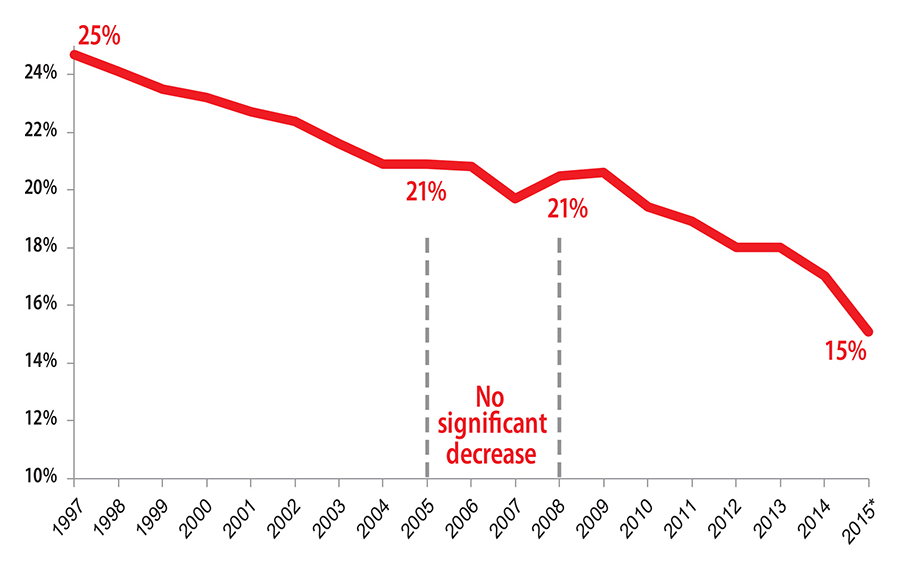
CDC / NCHS, National Health Interview Survey, 1997–2015, Sample Adult Core component; *2015 data are preliminary; https://www.cdc.gov/nchs/data/nhis/earlyrelease/earlyrelease201605_08.pdf
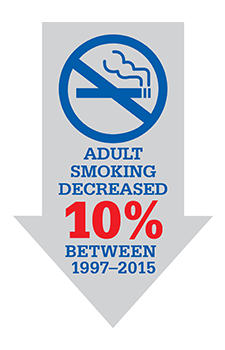
Trends in Tobacco Winnable Battle Indicators.
Trends in percentage of adults who smoke cigarettes, 2006 – 2015
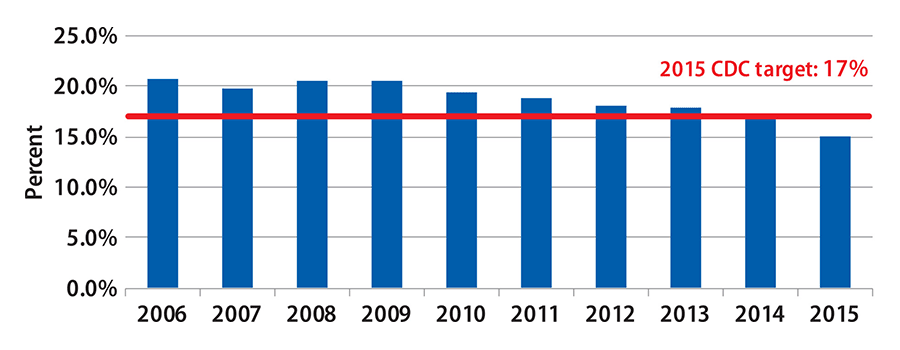
Source: National Health Interview Survey (NHIS)
Trends in percentage of youth who smoke cigarettes, 2007 – 2015
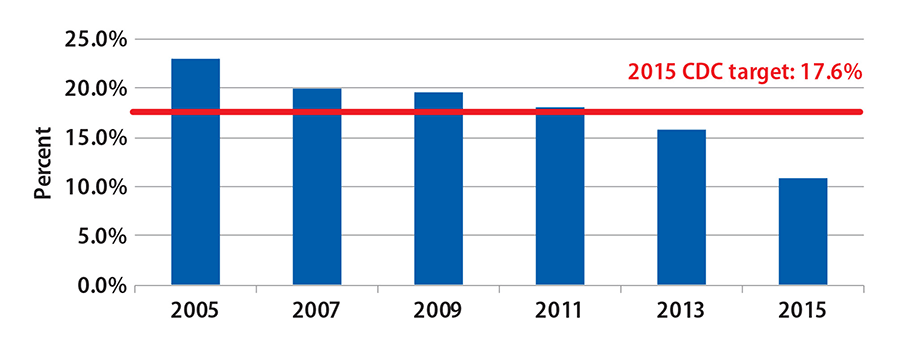
Source: Youth Risk Behavior Surveillance System (YBRSS)
Trends in proportion of U.S. population covered by comprehensive state and/or local laws making workplaces, including restaurants and bars, smoke-free, 2007 – 2016

Source: American’s for Nonsmokers’ Rights (ANR), CDC
Considerations in Choosing Tobacco as a Winnable Battle
- Smoking was the leading cause of preventable death in 2010 and remains so.
- When Winnable Battles began, an estimated 46 million American adults currently smoked cigarettes and cigarette smoking caused approximately 443,000 deaths annually.
- HHS was developing Ending the Tobacco Epidemic, A Tobacco Control Strategic Action Plan for the U.S. Department of Health and Human Services, released November 2010 and outlining proven strategies for tobacco prevention and control.
Challenges / Obstacles
- The range of emerging tobacco products, including e-cigarettes, complicates the current public health landscape.
- States have billions of dollars from tobacco taxes and tobacco industry legal settlements to prevent and control tobacco use. However, states currently use a very small amount of these funds for tobacco control programs.
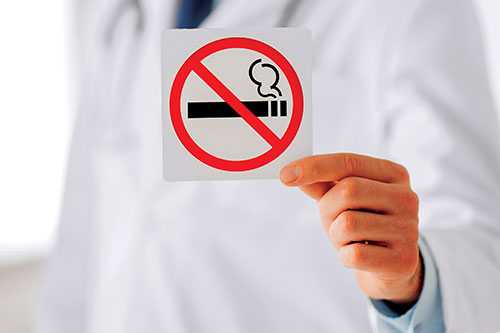
CDC Contributions in Tobacco Winnable Battle Initiative
Monitoring tobacco use and prevention policies
- The 50th Anniversary Surgeon General’s Report, The Health Consequences of Smoking — 50 Years of Progress, was released in January 2014. Despite progress, smoking and exposure to secondhand smoke are responsible for more than 480,000 premature deaths annually and more than $300 billion in health care expenses and other economic costs each year.
- Patterns of youth tobacco product use continue to be monitored through the National Youth Tobacco Survey. As of 2014, e-cigarettes became the most commonly used tobacco product among U.S. youth. In 2015, e-cigarettes were the most commonly used tobacco product among high school students (16.0%) and middle school students (5.3%).
Protecting people from secondhand smoke
- In 2014, 76 municipalities around the country acted to protect the public from exposure to secondhand smoke by implementing smoke free ordinances. In 2015, an additional 72 municipalities did so. As of June 2016, nearly 60% of Americans were covered by comprehensive laws making all indoor areas of workplaces, restaurants, and bars 100% smoke-free. Twenty-seven states and the District of Columbia have comprehensive statewide smoke-free laws as of June 30, 2016.
- In 2015 and into 2016, CDC has provided the Department of Housing and Urban Development (HUD) with technical assistance in proposing and planning to implement a smoke-free policy in public housing. Once final, the rule would cover more than 700,000 units, protecting residents from exposure to secondhand smoke. A CDC study found that prohibiting smoking in public housing would yield annual cost savings of $153 million from averted secondhand smoke-related care, renovation expenses, and smoking-attributable fire losses.
Offering help to quit tobacco use and warning about the dangers of tobacco
- The multi-year campaign “Tips from Former Smokers” which reignited national awareness of the health consequences of tobacco use inspired greater call volume to 1-800-QUIT-NOW than ever before. The TIPS campaign has proven to be a “best buy” in public health by costing just $393 to save a year of life, well under the widely accepted limit for the cost-effectiveness of a public health program of $50,000 per year of life saved. Between 2012 – 2015, Tips has helped at least 400,000 smokers quit for good and remains effective over time.
Working with states to enforce bans on tobacco advertising, promotion, and sponsorship and raise tobacco taxes
- Two states and the District of Columbia increased tobacco taxes in 2014, a proven strategy to reduce tobacco use. An additional nine states raised tobacco taxes in 2015, and one state raised the minimum price.
State Spotlight: Hawaii and Tobacco Control
State comprehensive tobacco control programs work and are a public health “best buy.” Comprehensive tobacco control programs promote tobacco cessation, prevent tobacco initiation, eliminate deadly secondhand smoke exposure, and eliminate tobacco-related disparities. Key elements of these programs include policies such as comprehensive smoke free policies, raising the price of tobacco products, and protecting local control by eliminating preemption.
Hawaii has worked for decades on all of these policy approaches, including passing a comprehensive smoke free law in 2006 and raising the cigarette excise tax rate from $1.00 in 2000 to its current rate of $3.20. As a result of these policy approaches, as well as strong public education campaigns and investment in tobacco prevention and control, Hawaii has seen dramatic results in health outcomes. For example, in 2013, the high school cigarette smoking rate in Hawaii was 10.4% — much lower than the national rate of 15.7%.
In May 2015, Hawaii added electronic nicotine delivery systems, including e-cigarettes, to its comprehensive statewide smoke free law — protecting bystanders from involuntary exposure to aerosolized nicotine and maintaining “clean air” as the public health standard. Nicotine exposure can harm pregnant women and their fetuses, as well as damage brain development. Hawaii is now one of five states that has expanded its comprehensive smoke free protections to electronic nicotine delivery systems.
In May 2015, Hawaii also became the first state to approve raising the legal age of sale of tobacco products to 21 — a promising best practice supported by the scientific literature. This new policy is expected to substantially reduce tobacco use and initiation, especially among teens between 15 and 17 years old.
- Page last reviewed: November 8, 2016
- Page last updated: November 8, 2016
- Content source:


 ShareCompartir
ShareCompartir